Question 1
Consider `f(x) = ln x - e^(cos x)`, `0 < x <= 10`.
(a) Sketch the graph of `y = f(x)`, stating the coordinates of any maximum and minimum points and points of intersection with the `x`-axis.
(b) Solve the inequality `ln x <= e^(cos x)`, `0 < x <= 10`.
Mark as Complete
Mark Scheme
Question 2
Let `f(x) = ln x`. The graph of `f` is transformed into the graph of the function `g` by a translation of `((3), (-2))`, followed by a reflection in the `x`-axis. Find an expression for `g(x)`, giving your answer as a single logarithm.
Mark as Complete
Mark Scheme
Question 3
Consider the function `f` defined by `f(x) = 90e^(-0.5x)` for `x in RR`.
The graph of `f` and the line `y = x` intersect at point P.
(a) Find the `x`-coordinate of P.
The line `L` has a gradient of `-1` and is tangent to the graph of `f` at the point Q.
(b) Find the exact coordinates of Q.
(c) Show that equation of `L` is `y = -x + 2 ln 45 + 2`.
The shaded region `A` is enclosed by the graph of `f` and the lines `y = x` and `L`.
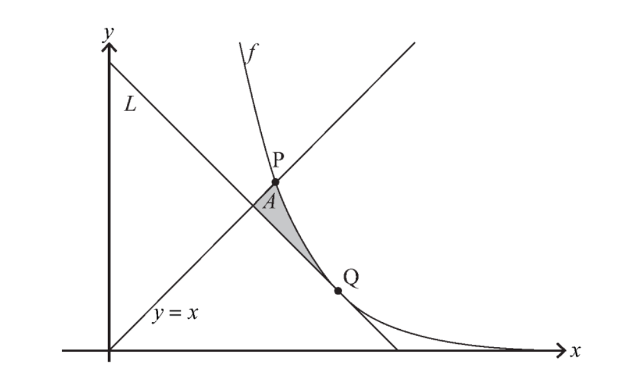
(d)
(i) Find the `x`-coordinate of the point where `L` intersects the line `y=x`.
(ii) Hence find the area of `A`.
The line `L` is tangent to the graph of both `f` and the inverse function `f^-1`.
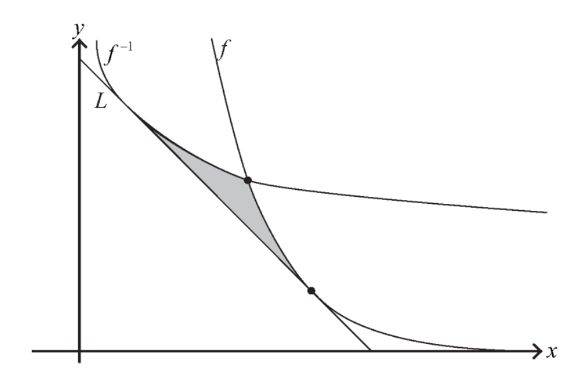
(e) Find the shaded area enclosed by the graphs of `f` and `f^-1` and the line `L`.
Mark as Complete
Mark Scheme
Question 4
Consider the function `f(x)=e^x - 3x - 4`.
(a) On the following axes, sketch the graph of `f` for `-4 <= x <= 3`.
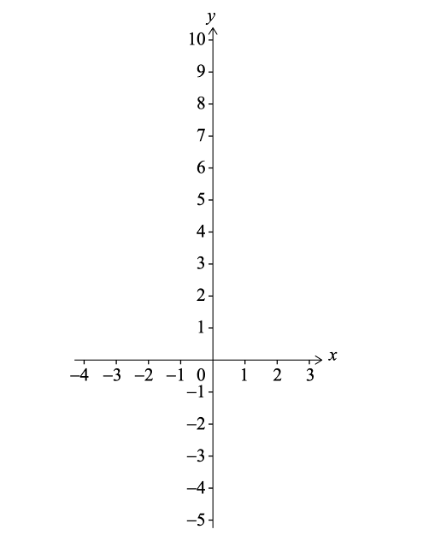
The function `g` is defined by `g(x)=e^(2x) - 6x -7`.
(b) The graph of `g` is obtained from the graph of `f` by a horizontal stretch with scale factor `k`, followed by a vertical translation of `c` units.
Find the value of `k` and the value of `c`.
Mark as Complete
Mark Scheme
Question 5
The diagram below shows a sketch of the graph of `y=f(x)`.

(a) Sketch the graph of `y=f^-1 (x)` on the same axes.
(b) State the range of `f^-1`.
(c) Given that `f(x)=ln(ax+b)`, `x > 1`, find the value of `a` and the value of `b`.
Mark as Complete
Mark Scheme
Question 6
Consider the function `f` defined by `f(x)=ln(x^2-16)` for `x > 4`.
The following diagram shows part of the graph of `f` which crosses the `x`-axis at point A, with coordinates `(a, 0)`. The line `L` is the tangent to the graph of `f` at the point B.

(a) Find the exact value of `a`.
(b) Given that the gradient of `L` is `1/3`, find the `x`-coordinate of B.
Mark as Complete
Mark Scheme
Question 7
The function `f` is defined on the domain `[0, (3pi)/2]` by `f(x) = e^(-x) cos x`.
(a) State the two zeroes of `f`.
(b) Sketch the graph of `f`.
(c) The region bounded by the graph, the `x`-axis and the `y`-axis is denoted by `A` and the region bounded by the graph and the `x`-axis is denoted by `B`. Show that the ratio of the area of `A` to the area of `B` is
`(e^pi (e^(pi/2) + 1)) / (e^pi + 1)`
Mark as Complete
Mark Scheme
Question 8
A function `f` is defined by `f(x) = 1/2 (e^x + e^(-x))`, `x in RR`.
(a)
(i) Explain why the inverse function `f^(-1)` does not exist.
(ii) Show that the equation of the normal to the curve at the point P where `x = ln 3` is given by `9x + 12y - 9 ln 3 - 20 = 0`.
(iii) Find the `x`-coordinates of the points Q and R on the curve such that the tangents at Q and R pass through `(0, 0)`.
(b) The domain of `f` is now restricted to `x >= 0`.
(i) Find an expression for `f^(-1)(x)`.
(ii) Find the volume generated when the region bounded by the curve `y = f(x)` and the lines `x = 0` and `y = 5` is rotated through an angle of `2pi` radians about the `y`-axis.
Mark as Complete
Mark Scheme
Question 9
The graph below shows `y = f(x)`, where `f(x) = x + ln x`.
(a) On the graph below, sketch the curve `y = f^(-1)(x)`.
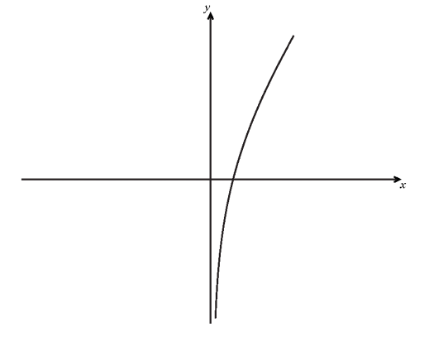
(b) Find the coordinates of the point of intersection of the graph of `y = f(x)` and the graph of `y = f^(-1)(x)`.
Mark as Complete
Mark Scheme
Question 10
Let `f(x) = a log_3(x - 4)`, for `x > 4`, where `a > 0`.
Point `A(13, 7)` lies on the graph of `f`.
(a) Find the value of `a`.
The `x`-intercept of the graph of `f` is `(5, 0)`.
(b) On the following grid, sketch the graph of `f`.

Mark as Complete
Mark Scheme
Question 1
Consider `f(x) = ln x - e^(cos x)`, `0 < x <= 10`.
(a) Sketch the graph of `y = f(x)`, stating the coordinates of any maximum and minimum points and points of intersection with the `x`-axis.
(b) Solve the inequality `ln x <= e^(cos x)`, `0 < x <= 10`.
(a)

A correct graph shape for `0 < x <= 10`.
maxima `(3.78, 0.882)` and `(9.70, 1.89)`
minimum `(6.22, -0.885)`
`x`-intercepts `(1.97, 0)`, `(5.24, 0)` and `(7.11, 0)`
(b) `0 < x <= 1.97`
`5.24 <= x <= 7.11`
Question 2
Let `f(x) = ln x`. The graph of `f` is transformed into the graph of the function `g` by a translation of `((3), (-2))`, followed by a reflection in the `x`-axis. Find an expression for `g(x)`, giving your answer as a single logarithm.
`h(x) = f(x - 3) - 2 = ln(x - 3) - 2`
`g(x) = -h(x) = 2 - ln(x - 3) = ln e^2 - ln(x - 3) = ln(e^2 / (x - 3))`
Question 3
Consider the function `f` defined by `f(x) = 90e^(-0.5x)` for `x in RR`.
The graph of `f` and the line `y = x` intersect at point P.
(a) Find the `x`-coordinate of P.
The line `L` has a gradient of `-1` and is tangent to the graph of `f` at the point Q.
(b) Find the exact coordinates of Q.
(c) Show that equation of `L` is `y = -x + 2 ln 45 + 2`.
The shaded region `A` is enclosed by the graph of `f` and the lines `y = x` and `L`.

(d)
(i) Find the `x`-coordinate of the point where `L` intersects the line `y=x`.
(ii) Hence find the area of `A`.
The line `L` is tangent to the graph of both `f` and the inverse function `f^-1`.

(e) Find the shaded area enclosed by the graphs of `f` and `f^-1` and the line `L`.
(a) attempt to find the point of intersection of the graph of `f` and the line `y = x`
`x = 5.56619 ... = 5.57`
(b) `f'(x) = -45e^(-0.5x)`
attempt to set the gradient of `f` equal to `-1`
`-45e^(-0.5x) = -1`
Q has coordinates `(2 ln 45, 2)` (accept `(-2 ln(1/45), 2)`)
(c) attempt to substitute the coordinates of Q (in any order)
into an appropriate equation
`y - 2 = -(x - 2 ln 45)` OR `2 = - (2 ln 45) + c`
equation of `L` is `y = -x + 2 ln 45 + 2`
(d)
(i) `x = ln 45 + 1 = 4.81`
(ii) appropriate method to find the sum of two areas using integrals of the difference of two functions
`int_(4.806...)^(5.566...) (x - (-x + 2 ln 45 + 2)) dx + int_(5.566...)^(7.613...) (90e^(-0.5x) - (-x + 2 ln 45 + 2)) dx`
`= 1.51965 ...`
`= 1.52`
(e) by symmetry `2 xx 1.52`
`= 3.03930 ...`
`= 3.04`
Question 4
Consider the function `f(x)=e^x - 3x - 4`.
(a) On the following axes, sketch the graph of `f` for `-4 <= x <= 3`.

The function `g` is defined by `g(x)=e^(2x) - 6x -7`.
(b) The graph of `g` is obtained from the graph of `f` by a horizontal stretch with scale factor `k`, followed by a vertical translation of `c` units.
Find the value of `k` and the value of `c`.
(a)
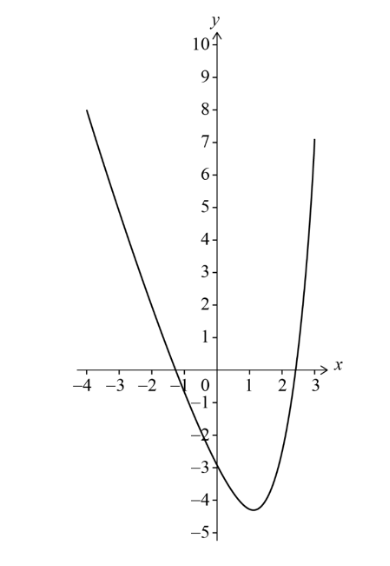
(b) `k=1/2, c=-3` (accept translate/shift 3 (units) down)
Question 5
The diagram below shows a sketch of the graph of `y=f(x)`.

(a) Sketch the graph of `y=f^-1 (x)` on the same axes.
(b) State the range of `f^-1`.
(c) Given that `f(x)=ln(ax+b)`, `x > 1`, find the value of `a` and the value of `b`.
(a)
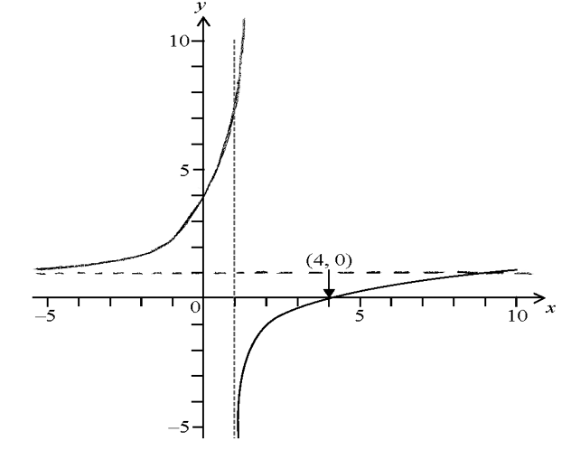
shape with `y`-axis intercept `(0,4)`
correct asymptote `y = 1`
(b) range is `f^-1 (x) > 1`
(c) `(4,0) => ln(4a+b)=0 => 4a+b=1`
asymptote at `x=1 => a+b=0`
`=> a=1/3, b=-1/3`
Question 6
Consider the function `f` defined by `f(x)=ln(x^2-16)` for `x > 4`.
The following diagram shows part of the graph of `f` which crosses the `x`-axis at point A, with coordinates `(a, 0)`. The line `L` is the tangent to the graph of `f` at the point B.

(a) Find the exact value of `a`.
(b) Given that the gradient of `L` is `1/3`, find the `x`-coordinate of B.
(a) `ln(x^2 - 16) = 0`
`e^0 = x^2 - 16 = 1`
`x^2 = 17` OR `x = +- sqrt(17)`
`a = sqrt(17)`
(b) attempt to differentiate (must include `2x` and/or `1 / (x^2 - 16)`)
`f'(x) = (2x) / (x^2 - 16)`
setting their derivative `= 1/3`
`(2x) / (x^2 - 16) = 1/3`
`x^2 - 16 = 6x` OR `x^2 - 6x - 16 = 0` (or equivalent)
valid attempt to solve their quadratic
`x = 8`
Question 7
The function `f` is defined on the domain `[0, (3pi)/2]` by `f(x) = e^(-x) cos x`.
(a) State the two zeroes of `f`.
(b) Sketch the graph of `f`.
(c) The region bounded by the graph, the `x`-axis and the `y`-axis is denoted by `A` and the region bounded by the graph and the `x`-axis is denoted by `B`. Show that the ratio of the area of `A` to the area of `B` is
`(e^pi (e^(pi/2) + 1)) / (e^pi + 1)`
(a) `e^(-x) cos x = 0 => x = pi/2, (3pi)/2`
(b)

(c) attempt at integration by parts
`I = int e^(-x) cos x dx = e^(-x) sin x + int e^(-x) sin x dx`
`=> I =e^(-x) sin x -e^(-x) cos x - int e^(-x) cos x dx`
`=> I = e^(-x) / 2 (sin x - cos x) + C`
`int_0^(pi/2) e^(-x) cos x dx = [e^(-x) / 2 (sin x - cos x)]_0^(pi/2) = e^(-pi/2) / 2 + 1/2`
`int_(pi/2)^((3pi)/2) e^(-x) cos x dx = [e^(-x) / 2 (sin x - cos x)]_(pi/2)^((3pi)/2) = -e^(-(3pi)/2) / 2 - e^(-pi/2) / 2`
ratio of `A : B` is `(e^(-pi/2) / 2 + 1/2) / (e^(-(3pi)/2) / 2 + e^(-(pi)/2) / 2)`
`(e^((3pi)/2) (e^(-pi/2) + 1)) / (e^((3pi)/2) (e^(-(3pi)/2) + e^(-pi/2))) = (e^pi (e^(pi/2) + 1)) / (e^pi + 1)`
Question 8
A function `f` is defined by `f(x) = 1/2 (e^x + e^(-x))`, `x in RR`.
(a)
(i) Explain why the inverse function `f^(-1)` does not exist.
(ii) Show that the equation of the normal to the curve at the point P where `x = ln 3` is given by `9x + 12y - 9 ln 3 - 20 = 0`.
(iii) Find the `x`-coordinates of the points Q and R on the curve such that the tangents at Q and R pass through `(0, 0)`.
(b) The domain of `f` is now restricted to `x >= 0`.
(i) Find an expression for `f^(-1)(x)`.
(ii) Find the volume generated when the region bounded by the curve `y = f(x)` and the lines `x = 0` and `y = 5` is rotated through an angle of `2pi` radians about the `y`-axis.
(a)
(i) either counterexample or sketch or
recognizing that `y = k` (`k > 1`) intersects the graph of `y = f(x)` twice
function is not `1–1` (does not obey horizontal line test)
so `f^(-1)` does not exist
(ii) `f'(x) = 1/2 (e^x - e^(-x))`
`f'(ln 3) = 4/3 \ \ (= 1.33)`
`m = -3/4`
`f(ln 3) = 5/3 \ \ (= 1.67)`
`(y - 5/3) / (x - ln 3) = -3/4`
`4y - 20/3 = -3x + 3 ln 3`
`9x + 12y - 9 ln 3 - 20 = 0`
(iii) The tangent at `(a, f(a))` has equation `y - f(a) = f'(a)(x - a)`.
`f'(a) = f(a) / a` (or equivalent)
`e^a - e^(-a) = (e^a + e^(-a)) / a` (or equivalent)
attempting to solve for `a`
`a = +- 1.20`
(b)
(i) `2y = e^x + e^(-x)`
`e^(2x) - 2y e^x + 1 = 0`
`e^x = (2y +- sqrt(4y^2 - 4)) / 2`
`e^x = y +- sqrt(y^2 - 1)`
`x = ln(y +- sqrt(y^2 - 1))`
`f^(-1)(x) = ln(x + sqrt(x^2 - 1))`
(ii) `V = pi int_1^5 (ln(y + sqrt(y^2 - 1)))^2 dy = 37.1 \ (units^3)`
Question 9
The graph below shows `y = f(x)`, where `f(x) = x + ln x`.
(a) On the graph below, sketch the curve `y = f^(-1)(x)`.

(b) Find the coordinates of the point of intersection of the graph of `y = f(x)` and the graph of `y = f^(-1)(x)`.
(a)
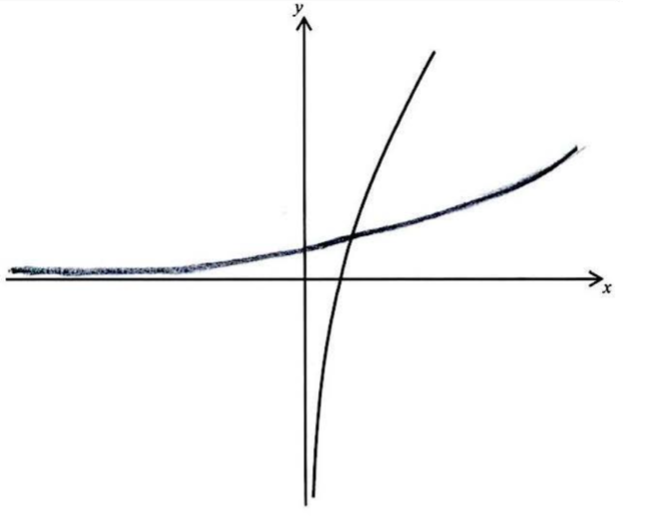
(b) intersect on `y = x`
`x + ln x = x => ln x = 0`
intersect at `(1, 1)`
Question 10
Let `f(x) = a log_3(x - 4)`, for `x > 4`, where `a > 0`.
Point `A(13, 7)` lies on the graph of `f`.
(a) Find the value of `a`.
The `x`-intercept of the graph of `f` is `(5, 0)`.
(b) On the following grid, sketch the graph of `f`.

(a) attempt to substitute coordinates (in any order) into `f`
e.g. `a log_3(13 - 4) = 7`, `a log_3(7 - 4) = 13`, `a log_3 9 = 7`
finding `log_3 9=2` (seen anywhere)
e.g. `log_3 9=2, 2a=7`
`a=7/2`
(b)
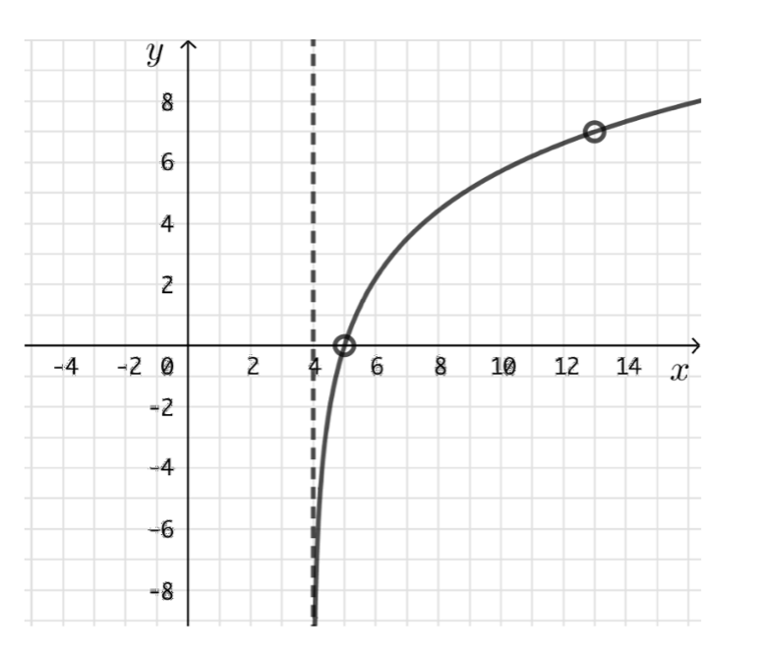
Question 1
Consider `f(x) = ln x - e^(cos x)`, `0 < x <= 10`.
(a) Sketch the graph of `y = f(x)`, stating the coordinates of any maximum and minimum points and points of intersection with the `x`-axis.
(b) Solve the inequality `ln x <= e^(cos x)`, `0 < x <= 10`.
Question 2
Let `f(x) = ln x`. The graph of `f` is transformed into the graph of the function `g` by a translation of `((3), (-2))`, followed by a reflection in the `x`-axis. Find an expression for `g(x)`, giving your answer as a single logarithm.
Question 3
Consider the function `f` defined by `f(x) = 90e^(-0.5x)` for `x in RR`.
The graph of `f` and the line `y = x` intersect at point P.
(a) Find the `x`-coordinate of P.
The line `L` has a gradient of `-1` and is tangent to the graph of `f` at the point Q.
(b) Find the exact coordinates of Q.
(c) Show that equation of `L` is `y = -x + 2 ln 45 + 2`.
The shaded region `A` is enclosed by the graph of `f` and the lines `y = x` and `L`.

(d)
(i) Find the `x`-coordinate of the point where `L` intersects the line `y=x`.
(ii) Hence find the area of `A`.
The line `L` is tangent to the graph of both `f` and the inverse function `f^-1`.

(e) Find the shaded area enclosed by the graphs of `f` and `f^-1` and the line `L`.
Question 4
Consider the function `f(x)=e^x - 3x - 4`.
(a) On the following axes, sketch the graph of `f` for `-4 <= x <= 3`.

The function `g` is defined by `g(x)=e^(2x) - 6x -7`.
(b) The graph of `g` is obtained from the graph of `f` by a horizontal stretch with scale factor `k`, followed by a vertical translation of `c` units.
Find the value of `k` and the value of `c`.
Question 5
The diagram below shows a sketch of the graph of `y=f(x)`.

(a) Sketch the graph of `y=f^-1 (x)` on the same axes.
(b) State the range of `f^-1`.
(c) Given that `f(x)=ln(ax+b)`, `x > 1`, find the value of `a` and the value of `b`.
Question 6
Consider the function `f` defined by `f(x)=ln(x^2-16)` for `x > 4`.
The following diagram shows part of the graph of `f` which crosses the `x`-axis at point A, with coordinates `(a, 0)`. The line `L` is the tangent to the graph of `f` at the point B.

(a) Find the exact value of `a`.
(b) Given that the gradient of `L` is `1/3`, find the `x`-coordinate of B.
Question 7
The function `f` is defined on the domain `[0, (3pi)/2]` by `f(x) = e^(-x) cos x`.
(a) State the two zeroes of `f`.
(b) Sketch the graph of `f`.
(c) The region bounded by the graph, the `x`-axis and the `y`-axis is denoted by `A` and the region bounded by the graph and the `x`-axis is denoted by `B`. Show that the ratio of the area of `A` to the area of `B` is
`(e^pi (e^(pi/2) + 1)) / (e^pi + 1)`
Question 8
A function `f` is defined by `f(x) = 1/2 (e^x + e^(-x))`, `x in RR`.
(a)
(i) Explain why the inverse function `f^(-1)` does not exist.
(ii) Show that the equation of the normal to the curve at the point P where `x = ln 3` is given by `9x + 12y - 9 ln 3 - 20 = 0`.
(iii) Find the `x`-coordinates of the points Q and R on the curve such that the tangents at Q and R pass through `(0, 0)`.
(b) The domain of `f` is now restricted to `x >= 0`.
(i) Find an expression for `f^(-1)(x)`.
(ii) Find the volume generated when the region bounded by the curve `y = f(x)` and the lines `x = 0` and `y = 5` is rotated through an angle of `2pi` radians about the `y`-axis.
Question 9
The graph below shows `y = f(x)`, where `f(x) = x + ln x`.
(a) On the graph below, sketch the curve `y = f^(-1)(x)`.

(b) Find the coordinates of the point of intersection of the graph of `y = f(x)` and the graph of `y = f^(-1)(x)`.
Question 10
Let `f(x) = a log_3(x - 4)`, for `x > 4`, where `a > 0`.
Point `A(13, 7)` lies on the graph of `f`.
(a) Find the value of `a`.
The `x`-intercept of the graph of `f` is `(5, 0)`.
(b) On the following grid, sketch the graph of `f`.
